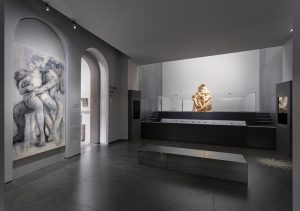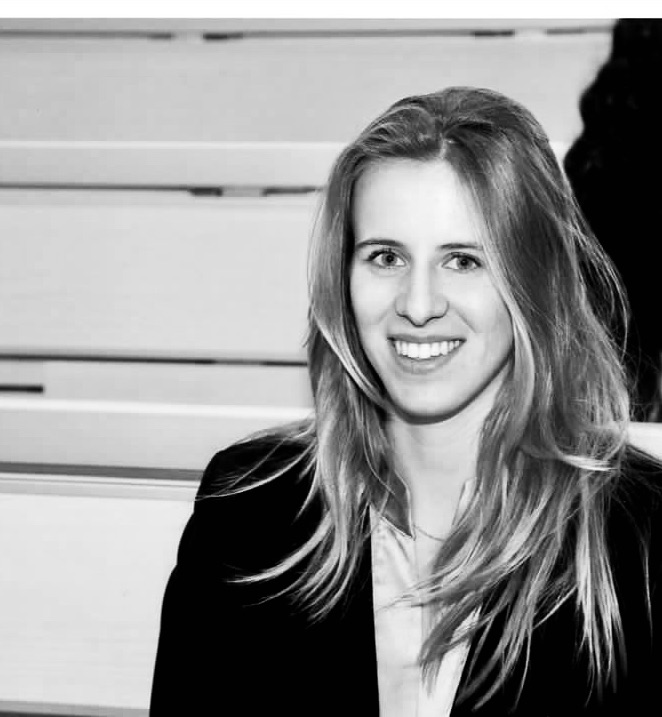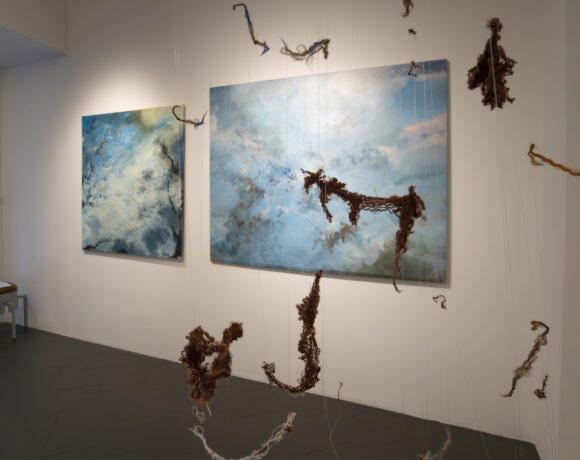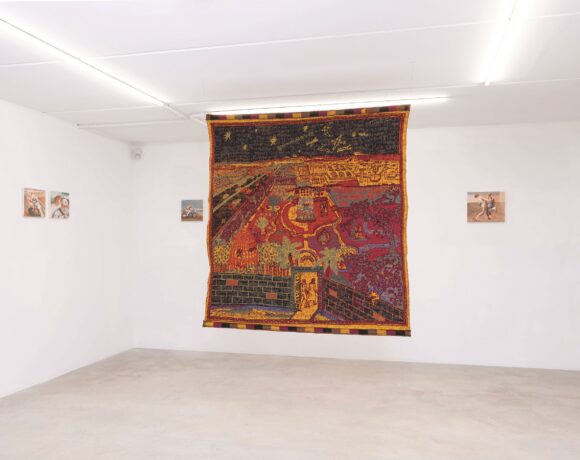The renowned English artist Jenny Saville returns to Italy, in Florence, with a new exceptional exhibition. The show, curated by the director of the Museo del Novecento Sergio Risaliti, with the support of Gagosian, aims to retrace the artist’s pictorial activity from her first successes in the nineties, until today. Through a path that branches off throughout the historic center, involving five of the most important institutions of the Medici city, Saville leads the viewer through a dynamic dialogue between Contemporary and Renaissance, with a constant reflection on the timeless legacy of the Great Italian Masters.
Jenny Saville, born in 1970, attracted the attention of contemporary critics since her debut in the early nineties when her works were included in the collection of Charles Saatchi and then exhibited along with the works of the British Young Artist group. Her artistic research is characterized by an incessant interest in imperfections and vulnerabilities of the body that led her in 1994 to study human anatomy by assisting a plastic surgeon in New York. Thanks to this experience Saville learns the mechanisms of tissue and skin manipulation, pain and suffering inherent in cosmetic surgery procedures.
Her figures appear grotesque, with flaccid and shapeless limbs, characterized by a sexual intermediation that disregards gender and that defies the stereotypical canons of beauty imposed by contemporary society. Their drama is amplified by a monumental language in which figurative and abstract mix in a dynamic sign, fluid and sketchy. Saville masterfully alternates oil, charcoal and pastel, dominating with energetic sketches dense textured brushstrokes of color. Art critic and historian Linda Nochlin defined her painting as “a language that inscribes a conflict at the same time visceral and intellectual, between the naturalism of the subject’s pictorial subservient and the energy seemingly pictorial and almost abstract brushstroke”.
The technical quality of the sign of Saville clearly emerges in her personal exhibition in Florence, in particular in the corpus of works exhibited at the Museo del Novecento, where a hundred works, including paintings on canvas and sketches on paper, alternate creating a tale dedicated to the mutability of the female body. On the ground floor there are a dozen portraits with bright colors and characterized by an engaging and suggestive sensitivity. Strongly ambiguous, the faces provoke in the spectator a sense of anxiety, where repulsion and fascination fight each other. In particular we mention Self-portrait (After Rembrandt), the artist’s self-portrait, inspired by Self-portrait with Two Circles by Rembrandt and Rosetta II. The latter, located above the altar inside the former Spedale church, portraying a young blind Italian woman met by Saville during a stay in the peninsula. The face tilted severely upwards in a pose of ecstatic contemplation and the veiled bright blue eyes express a feeling of strength and suffering that destabilizes and obliges the viewer to look away. Related to the wooden Crucifix by Giotto, suspended in the middle of the nave of Santa Maria Novella, Rosetta II is just an example of the artist’s bond with the city.
This is even more evident in Study for Pietà, at the Museo dell’Opera del Duomo in Florence, where Saville iconographically transposes Michelangelo’s last great feat, the marble sculpture of the Pietà Bandini. The large-format design, almost three meters high, presents itself as a contemporary counterbalance to daily suffering: the semi-dressed characters hold in their arms the lifeless body of a young boy, probably the victim of some political or ideological principle. The impossibility of recognizing its identity or a cultural belonging gives the figures a universal meaning against any brutality of the war.
The relationship with Michelangelo continues at Casa Buonarotti, where a second theme close to Saville emerges – maternity – about which the artist explains: “After having children, I wanted to find an art that was like the crudeness of childbirth. I lived for a long time in Sicily, so being in Palermo around those myths and ancient history has really tied me to that and the myths of the ancient Greek world. . . gods and goddesses and the power of fertility. So this is filtered out a lot in my work then and is a great driving force in my life now, especially in the drawings, a kind of creative impulse“.
The canvas, The Mothers, on display at the Museo degli Innocenti, portrays a woman with a swollen belly and a suffering expression, while holding in her arms two children struggling to escape her embrace. Placed in front of the Madonna and Child by Andrea della Robbia and Sandro Botticelli, the work reveals the timelessness of a theme whose representative possibilities are not exhausted with the passage of time. The three bodies seem to intrigue each other, from the chest of one of the children emerges a rough foot, while the other seems to be fused into the mother’s body that is inspired by the same artist.
What is simply mentioned in The Mothers reaches its peak in Fulcrum, exposed at the entrance of the Battle Hall, at Palazzo Vecchio. On a monumental canvas three female bodies poured over each other appear fused together in a dramatic embrace. While the torsion of the bodies recalls the sculptural groups of the Labours of Hercules by Vincenzo de Rossi and the Genius of Victory by Michelangelo, the massive limbs are in contrast with the muscularity of Michelangelo’s soldiers and horses of the Vasari frescoes.
Mariavittoria Pirera
Info:
JENNY SAVILLE
30.09.2021-20.02.2022
www.museonovecento.it
 Jenny Saville, installation view at Museo Novecento Firenze © Jenny Saville. All rights reserved, DACS 2021 Photo: Sebastiano Pellion di Persano Courtesy Gagosian
Jenny Saville, installation view at Museo Novecento Firenze © Jenny Saville. All rights reserved, DACS 2021 Photo: Sebastiano Pellion di Persano Courtesy Gagosian
 Jenny Saville, installation view at Museo Novecento Firenze © Jenny Saville. All rights reserved, DACS 2021 Foto: Sebastiano Pellion di Persano Courtesy Gagosian
Jenny Saville, installation view at Museo Novecento Firenze © Jenny Saville. All rights reserved, DACS 2021 Foto: Sebastiano Pellion di Persano Courtesy Gagosian
 Jenny Saville, Fulcrum, 1999 © Jenny Saville. All rights reserved, DACS 2021 Private collection. Courtesy Gagosian
Jenny Saville, Fulcrum, 1999 © Jenny Saville. All rights reserved, DACS 2021 Private collection. Courtesy Gagosian
 Jenny Saville, Study for Pentimenti III (sinopia), 2011 © Jenny Saville. All rights reserved, DACS 2021 Photo: Mike Bruce. Private collection. Courtesy the artist and Gagosian
Jenny Saville, Study for Pentimenti III (sinopia), 2011 © Jenny Saville. All rights reserved, DACS 2021 Photo: Mike Bruce. Private collection. Courtesy the artist and Gagosian

Mariavittoria Pirera, born in 1995, has a historical-artistic education obtained with a three-year degree in History of Cultural Heritage, historical-artistic profile, at Università Cattolica del Sacro Cuore, Milan, and with a master’s degree in History and Conservation of artistic heritage, contemporary art history, at Ca’ Foscari University, Venice. She lives and works in Milan.






NO COMMENT